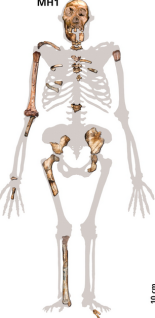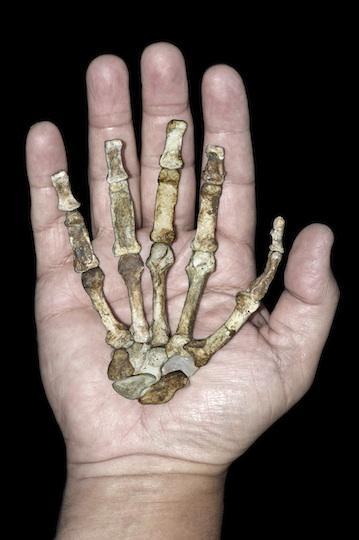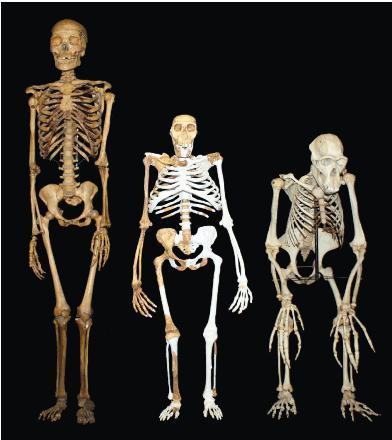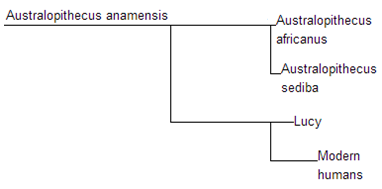Australopithecus sediba, everyone’s second favorite Australopith after Lucy, was back in the news last week as more research on this fascinating specie was published. First discovered in South Africa in 2008, the species made headlines when preliminary investigations revealed that they were a mixture of earlier ape-like (Australopith) and modern traits (Homo). This raised the intriguing possibility that we’d discovered the “ape man” (or ape woman, if you prefer) from which the more modern-looking species evolved.

MH1; one of the Australopithecus sediba skeletons found
Such hopes were short lived however, as it was discovered Au. sediba was ~1.9 million years old (Pickering et al., 2011). Since the first members of Homo lived 2.3 million years ago (Aiello and Wells, 2002), Au. sediba obviously couldn’t have been their ancestor (unless they had a Delorean. That always leads to weird family relations). Some maintain that the earliest members of Homo don’t actually belong to our genus, and that it actually evolved much later (Wood and Collard, 1999). If this is the case then Au. sediba could still take center stage in the story of our evolution.
At the very least Au. sediba appears to be closely related to the ancestor of Homo, even if they aren’t that ancestor themselves. As such they can provide valuable insights into the origins of our genus. Now the initial investigations have been completed and published, revealing how Australopithecus sediba moved, what they looked like and where they fit in our evolutionary tree (Berger, 2013).
These results confirm our earlier suspicions that Au. sediba had a mixture of ape-like Australopith and more modern Homo traits (when wanting to sound fancy, scientists refer to such a mixture as a “mosaic”). For example, they had a cone shaped rib-cage like Australopiths and modern apes (compared with our barrel shaped rib cage). However, the bottom of this rib-cone is much less slender than it is in an ape, being more similar to the human rib cage (Shmid et al., 2013).

The hand of sediba, with short stubby human-like fingers
Other such mosiac traits include the arm. This research shows that shoulder blade was orientated upwards (like an ape), so sediba would look like they were shrugging their shoulders. Such an orientation makes it easy to reach over their head, so their really long arms (again, like an ape) could grab onto branches (Churchill et al., 2013). However, whilst apes and earlier Australopiths have long curved fingers to “hook” onto branches, Au. sediba‘s fingers are short and stubby (Kivell et al., 2011). This is a human adaptation to better handle tools. Currently we only know of one species of Australopith that used stone tools; so this discovery suggests it may have been a lot more widespread than we thought.
Almost every aspect of Au. sediba‘s anatomy has a similar mix of modern and old traits; from the jaw through to their backbone. Put them all together and you wind up with something that looks like the image below. Definitely an ape-like Australopith, but with some key modern traits (Berger, 2013).

A modern human (left); sediba (middle) and chimp (right)
However, what I find the most interesting are those traits unique to sediba, not present in either other members of Australopithecus or Homo. Most notably this includes sediba‘s way of walking. Although they were bipdeal, like other Australopiths and humans (with many similar adaptations), an analysis of their lower limbs reveals they walked with their feet twisted slightly outwards. No other member of our family walks like this (DeSilva et al, 2013).
This unique way of walking has led some of the researchers involved in these new papers to suggest that Australopithecus sediba may not be as closely related to modern humans as early research suggested. They claim that sediba may have split from the human lineage millions of years earlier, before even Lucy lived (Schmid et al., 2013)!

A possible reconstruction of the human family tree, taking these new findings into account
If this is the case then it would mean that all their human-like adaptations were the result of convergant evolution. That there were multiple lineages independently evolving towards the modern human body plan. Perhaps this speaks to just how well adapted our form is for life in Africa. It also raises the fascinating possibility that had things played out a little differently there may have been another genus of tall, upright, smart hominins. Remember that Neanderthals, for all their differences, are still classified as the same genus as us. Imagine if a completely different genus of intelligent hominins had developed!
Although that’s a fascinating possibility, not all the researchers agree with it. Irish et al (2013) point out that some of sediba’s traits – such as the shape of their teeth – are so similar to Homo that it’s very unlikely both groups evolved them coincidentally. Their detailed analysis of sediba’s location in the human family tree place them much closer to humans; indicating both us and them developed from southern Australopiths, like Australopithecus africanus. This shows that the emergence of Homo was more complex than we thought, with multiple lineages emerging from our ancestors.
In short, this research shows that Australopithecuses sediba was the mosaic we thought it was. However, it’s unique features force us to change where we place it in the human family tree and by doing so we revolutionise our understanding of the entire course of human evolution; either by showing another lineage of hominins existed that was developing human-like traits coincidentally, or revealing the genesis of our genus was a lot more complicated than we thought. This is the final nail in the coffin of the idea that Au. sediba was the ancestor of modern humans, but frankly I am not disappointed. The ideas which replace it are just revolutionary.
References
Aiello, L. C., & Wells, J. C. (2002). Energetics and the evolution of the genus Homo. Annual Review of Anthropology, 323-338.
Berger, L. R. (2013). The Mosaic Nature of Australopithecus sediba. Science,340(6129), 163-165.
Churchill, S. E., Holliday, T. W., Carlson, K. J., Jashashvili, T., Macias, M. E., Mathews, S., … & Berger, L. R. (2013). The upper limb of Australopithecus sediba. Science, 340(6129).
Irish, J. D., Guatelli-Steinberg, D., Legge, S. S., de Ruiter, D. J., & Berger, L. R. (2013). Dental Morphology and the Phylogenetic “Place” of Australopithecus sediba. Science, 340(6129).Kivell, T. L., Kibii, J. M., Churchill, S. E., Schmid, P., & Berger, L. R. (2011). Australopithecus sediba hand demonstrates mosaic evolution of locomotor and manipulative abilities. Science, 333(6048), 1411-1417.
Pickering et al, (2011). Australopithecus sediba at 1.977 Ma and implications for the origins of the genus Homo. Science 333, 1421
Schmid, P., Churchill, S. E., Nalla, S., Weissen, E., Carlson, K. J., de Ruiter, D. J., & Berger, L. R. (2013). Mosaic Morphology in the Thorax of Australopithecus sediba. Science, 340(6129).
Wood, B., & Collard, M. (1999). The human genus. Science, 284(5411), 65-71.
(As an aside, I predict young earth creationists will respond to these findings by 1. playing up the ape-like nature of the ape/human mosaic traits and 2. using the fact that it’s relationship to humans is being re-evaluated to question whether it – and other Australopiths – is related to humans at all. They may also use the fact that first impressions were wrong to question the validity of palaeoanthropology all together)

